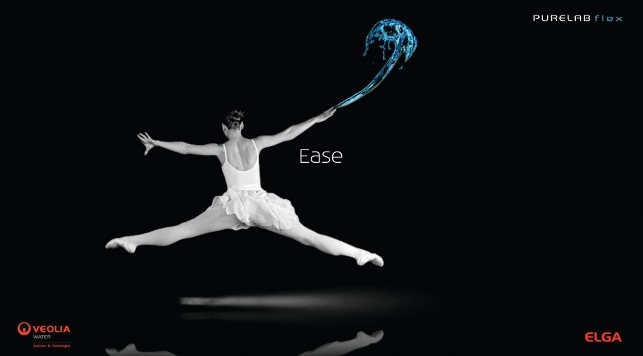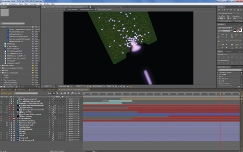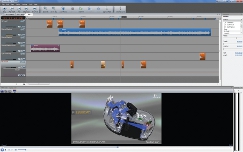Industrial design agency LA Design (London Associates) has started producing its own videos. No, they haven’t migrated from their product design roots to cinematography; it’s just another service they are now offering clients.

The opening sequence of the PURELAB flex promotional video
Using 3D CAD data, the designers create digital promotional movies for clients to use internally to help communicate a new product to the sales team, key stakeholders or for exhibitions and product launches.
“To us this is a logical extension of the design process,” explains Leslie Stokes, director of LA Design. Short videos are something that LA Design has been developing for the past few years and really came about due to the advancements in both hardware and software.
“We’ve been using Pro/Engineer and rendering the CAD side of things since 1995,” explains David Robinson, director of LA Design. “In those days, in order to do a good static render, it would mean rendering a single frame over a weekend for one image. Even if the animated sections could be a minor section of the video, it was just impossible to consider doing movies.”
Photo call
Once they had invested heavily in various rendering technologies, the agency soon realised that creating photo realistic renderings of a client’s product was, in many cases, better and faster than relying on an actual photograph of the physical prototype.
The next step was using these rendering tools and investing in some new hardware and software to create animations and to add post production.
“Advances in computer speed and the enhancements in motion graphics software, such as Adobe’s After Effects, have enabled designers to produce moving images to communicate the qualities of design,” says Robinson.
Previously if a client wanted a promotional video produced, it would have utilised a third party. However, the product design agency is ideally positioned to do this because, having been involved in bringing the product to life, it has far greater empathy with it.
“Although we sometimes create videos for products we haven’t designed, the best results do come from being involved in the whole product design and development process,” says Robinson.
“We’ve understood the user, we’ve been part of the product proposition in the first place and we really know what the client wants to communicate to others, whether it’s internal sales or the end customer.”
The design agency can also seamlessly move past the creation of data for production and utilise the same 3D CAD data for use in the promotional videos. “We have already created the data to make prototypes and tooling for manufacture.
For the movies we are using exactly the same data, once it’s optimised for rendering, mixed with other media to make a movie, so it’s highly efficient as well,” comments Robinson.
But Robinson stresses that they are not emulating Pixar by any stretch of the imagination. Instead they are creating engaging and elegant videos that can be used to explain how a product works and its key benefits. “Very often marketing material will contain a lot of words.
Really, this visual medium is about stripping down the number of words and communicating the same values through pictures of the product or with visual metaphor,” he explains.
“Visualisation can often show how something works in a way that no other medium achieves. There is also the ability to include a voice over or a music score, to add background sound texture or to make it more dramatic. Overall, it’s a surprisingly powerful medium.”
Final cut
Having created the PURELAB flex, a standalone ultrapure water system for use in laboratories, for client ELGA LabWater, part of Veolia Water Group, LA Design was also tasked with creating a promotional video.
The video was to be shown in Marrakech, Morocco, to over 80 members of the company’s sales team, who were accustomed to predictable corporate PowerPoint presentations.
As this new product was very different to anything the company had made before, it wanted LA Design to convey this in the video. “We revealed the product gradually, so it was very theatrical. In the opening scenes there was a black background with various images of a ballet dancer, to communicate the concept of flexibility,” describes Robinson.
“ELGA were delighted because the video really engendered enthusiasm from the sales people for the new product. In Japan they even projected a high definition version in a cinema. So, it went beyond their original brief of what they were going to use it for.”
Another client PerkinElmer, a manufacturer of advanced technology solutions in the human and environmental health industries, asked LA Design to create a video for its new Frontier spectrometer.
Typically used in pharmaceutical labs and for materials research, this is a very specialised and sophisticated instrument that measures the absorption of infrared light in a sample. It employs a very clever internal mirror system and infrared light beam, which no one ever gets to see functioning.
“The instrument has a patented oscillating mirror system inside, enabling superior measurement, and we were able to visualise these inner workings in the video,” says Robinson.
In fact the video was such a successful communication tool that it has since been translated it into eight languages and shown all over the world. PerkinElmer has even featured it on the product page of its website.
On closer inspection
LA Design has learnt that the videos have proven especially successful when used to visualise subjects that cannot be seen by the naked eye: either abstract technology or something working on a microscopic scale.
For instance, in a promotional video for ENDETEC, also part of the Veolia Water Group, the designers had to visualise the inner workings of the new Tecta B16 – rapid microbial detection instrument for E.coli and total coliforms.
This solution is a self-contained, automated testing system that enables laboratory-grade microbiological testing to be performed on-site, at the location where the samples are obtained. “The ‘real world‘ test sample looks like chocolate milkshake: you cannot see anything.
With the use of a video you can create little bacteria and E. coli with After Effects particle system, to help visualise the clever measuring process,” says Robinson. “For me it’s not unlike being a physics teacher at school and trying to make subjects engaging to get people onboard. There is nothing quite like a moving image to achieve that.”
Although the videos are short (typically around three minutes in length) a detailed script still has to be written and strategic, ordered preparation has to take place beforehand. “Of course there is the technical process of optimising the CAD data, collating other video and stills and then creating a set with lighting and music and so on. But you need to start with a vision, followed by a storyboard,” says Robinson.
Putting together the script or storyboard is a valuable collaborative process as it brings both the client’s engineering and marketing departments together as both sides want to ensure that the right values come across in the video. “Everyone becomes a stakeholder in this process,” says Robinson.
With the vision in place it’s time for Robinson and his team to start using the design tools to create a video that will convey the right message and explain the product in the best possible way. (See below for a list of the different tools used in this process).
Although Robinson is still very much an industrial designer, he is enjoying producing videos too. “For us, as many areas of design get commoditised and automated, this, as well as being a natural extension of the design process, taps into our enjoyment of being creative,” he explains. “The videos really seem to have taken on a life of their own. They are often challenging, but great fun to do.”
The tools used from the start of the video making process
To create the initial 3D data Pro/Engineer, SolidWorks and Autodesk Alias Design
To convert CAD data to polygonal model, reassign textures, optimise model and reduce polygon count Okino Nu-Graf
To create initial renders Luxology MODO 501 and Luxion Keyshot
To create music/sound Adobe Audition and Smartsound Sonicfire Pro
For animation Bunkspeed Hypermove and Luxology MODO 501
For motion graphics Adobe CS5 After Effects, with Trapcode Suite and Particle Illusion
Plus a lot of peripheral software. Especially Photoshop,Mindmanager, Office, Poser, Carrara
Typical essential hardware 64-bit Windows PC,Quadro FX4800 graphics card, 12GB RAM, a good HD video camera for live video capture, a kettle and plenty of coffee!
Moving pictures speak volumes for LA Design
Default









